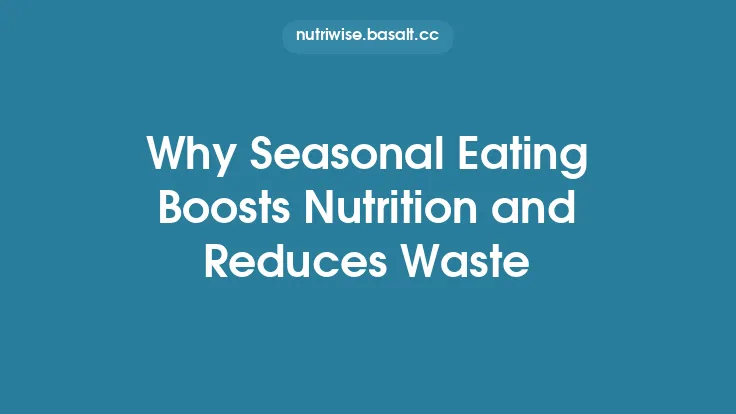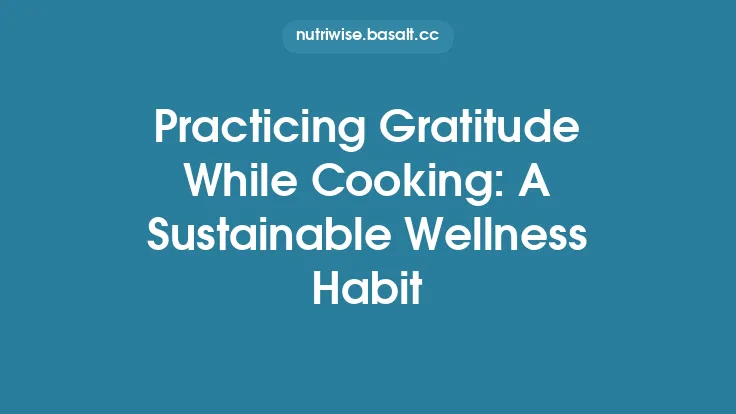Seasonal eating is more than a culinary trend; it is a holistic approach that aligns our plates with the natural rhythms of the planet. By choosing produce that is at its peak in a given region and time of year, we tap into a cascade of benefits that extend far beyond flavor. The practice reduces the energy and resources required to grow, transport, and store food, while simultaneously delivering nutrients in their most bioavailable form. When paired with intentional waste‑reduction strategies, seasonal eating becomes a powerful lever for both personal health and environmental stewardship.
Why Seasonal Eating Matters for Sustainability
- Lower Energy Expenditure: Crops grown out of season often rely on heated greenhouses, artificial lighting, or long‑distance transportation. Each of these steps consumes fossil fuels and adds greenhouse‑gas emissions. Consuming foods that are naturally in season eliminates many of these energy‑intensive inputs.
- Reduced Water Footprint: Seasonal produce typically aligns with local precipitation patterns, meaning irrigation needs are minimized. For example, a summer‑grown tomato in a Mediterranean climate may require little to no supplemental water, whereas the same fruit grown in a cooler, drier region would demand extensive irrigation.
- Preservation of Soil Health: Rotating crops according to seasonal cycles helps maintain soil biodiversity and reduces the need for synthetic fertilizers. When farmers can plant a variety of species that thrive at different times of the year, they naturally break pest cycles and improve organic matter content.
- Biodiversity Conservation: Supporting a market for diverse, locally adapted varieties encourages farmers to maintain heirloom and region‑specific cultivars, which are often more resilient to climate fluctuations and pests.
Understanding the Environmental Impact of Food Choices
| Impact Category | Conventional Out‑of‑Season Model | Seasonal, Local Model |
|---|---|---|
| Carbon Emissions | High (transport, refrigeration, greenhouse heating) | Low (shorter supply chains, minimal storage) |
| Water Use | Elevated (irrigation, processing) | Optimized (rain‑fed, efficient use) |
| Land Use | Intensive monocultures, higher pesticide load | Polyculture, crop rotation, lower chemical inputs |
| Food Waste | Higher due to over‑production and spoilage in transit | Lower because produce reaches market fresher and with longer shelf life |
Quantifying these differences can be done through life‑cycle assessment (LCA) tools, which calculate the total environmental burden from farm to fork. Many LCA studies show that the carbon intensity of a locally sourced apple in autumn can be up to 70 % lower than that of a greenhouse‑grown apple shipped from a distant region.
Seasonal Availability and Nutrient Density
Plants synthesize phytochemicals, vitamins, and minerals in response to their environment. When a fruit or vegetable is harvested at the height of its natural growth cycle, it typically contains:
- Higher concentrations of water‑soluble vitamins (e.g., vitamin C in summer berries, folate in spring greens) because the plant’s metabolic pathways are fully active.
- Enhanced antioxidant profiles that are not the focus of “seasonal antioxidant strategies” but arise organically as the plant defends itself against UV radiation, pests, or temperature stress.
- Improved flavor compounds (sugars, organic acids, volatile aromatics) that signal ripeness and encourage consumption before spoilage sets in.
These nutritional advantages are not merely anecdotal; controlled studies comparing the same cultivar grown in season versus out of season have documented up to a 30 % increase in key micronutrients and phytochemicals when harvested at peak maturity.
Practical Strategies to Reduce Food Waste
- Adopt the “First‑In, First‑Out” Principle
Organize pantry and refrigerator items so that older produce is placed at the front. This visual cue encourages consumption before newer items push older ones to the back, where they are forgotten.
- Portion Planning Based on Shelf Life
- Day‑to‑day perishables (berries, leafy greens) should be bought in quantities that match a 2‑3‑day consumption window.
- Mid‑term items (root vegetables, squashes) can be stocked for up to 2‑3 weeks if stored properly.
- Long‑term staples (dry beans, grains) can be purchased in bulk and rotated annually.
- Utilize By‑Products
- Stems, leaves, and peels often contain valuable nutrients. For example, carrot tops can be sautéed, and citrus peels can be candied or used to infuse water.
- Composting any unavoidable scraps returns organic matter to the soil, closing the nutrient loop.
- Implement a “Waste Audit”
Keep a simple log of discarded food items for a month. Identify patterns (e.g., over‑buying certain fruits) and adjust purchasing habits accordingly.
Smart Shopping and Storage Techniques
- Buy Directly from Farmers’ Markets or CSAs
Purchasing directly from growers reduces the number of handling steps, which often leads to fresher produce with a longer usable life.
- Select Produce with Intact Protective Layers
For example, choose apples with unblemished skins and potatoes with minimal sprouts. Intact skins act as natural barriers against moisture loss and microbial invasion.
- Temperature Zoning in the Refrigerator
- High‑humidity drawers for leafy greens and herbs (maintain moisture).
- Low‑humidity compartments for fruits that emit ethylene (e.g., apples, pears) to prevent premature ripening of nearby vegetables.
- Use Controlled‑Atmosphere (CA) Storage at Home
Simple CA methods—such as placing a paper towel in a sealed container with produce—can slow respiration rates and extend shelf life by 30‑50 %.
Preservation Methods that Retain Nutrition
While the article avoids “seasonal meal planning,” it can still discuss preservation as a means to bridge seasonal gaps without waste.
- Freezing
- Blanch vegetables briefly (1–3 minutes) before freezing to inactivate enzymes that degrade nutrients.
- Freeze fruits on a tray before bagging to prevent clumping, ensuring portion control.
- Fermentation
- Lacto‑fermentation of cabbage, carrots, or beets not only extends shelf life but also creates probiotic‑rich foods that support gut health.
- The low‑temperature, anaerobic environment preserves vitamins B and C better than many heat‑based methods.
- Dehydration
- Low‑temperature drying (below 55 °C) retains most phytonutrients while reducing weight and volume, making storage more efficient.
- Rehydrated produce can be incorporated into soups or stews, providing a nutrient boost without fresh‑produce waste.
- Vacuum Sealing
- Removing oxygen slows oxidative reactions that cause nutrient loss and spoilage. Pair vacuum sealing with refrigeration or freezing for optimal results.
Cooking Approaches that Maximize Nutrient Retention
- Steaming Over Boiling
Steaming vegetables for 3–5 minutes retains up to 90 % of water‑soluble vitamins compared to boiling, where nutrients leach into the cooking water.
- Short‑Duration, High‑Heat Techniques
Methods such as stir‑frying or sautéing quickly sear the exterior, preserving internal nutrients while developing flavor through Maillard reactions.
- Gentle Roasting
Roasting at 180–200 °C for 20–30 minutes caramelizes natural sugars, enhancing palatability without excessive nutrient degradation. Adding a modest amount of healthy fat (e.g., olive oil) improves the absorption of fat‑soluble compounds.
- Utilizing Cooking Liquids
When boiling is unavoidable (e.g., for legumes), repurpose the cooking broth as a base for soups or sauces to reclaim leached nutrients.
Integrating Community Resources and Local Food Systems
- Community‑Supported Agriculture (CSA) Shares
Subscribing to a CSA provides a predictable supply of seasonal produce, often harvested within 24 hours of delivery, minimizing post‑harvest loss.
- Food Co‑ops and Bulk Buying
Purchasing in bulk reduces packaging waste and can lower the carbon footprint per unit weight. Co‑ops often prioritize local growers, reinforcing regional food networks.
- Urban Gardens and Rooftop Farms
Even small‑scale gardening contributes to food security and reduces the distance food travels. Homegrown herbs, salad greens, and microgreens can be harvested continuously, cutting down on store‑bought waste.
- Local Food Hubs
These aggregators connect small farms with restaurants, schools, and institutions, creating economies of scale that make seasonal distribution more viable year‑round.
Measuring Success: Metrics and Tools
- Food Waste Tracker Apps
Digital platforms allow users to log discarded items, estimate the associated carbon emissions, and receive personalized tips for reduction.
- Carbon Footprint Calculators
Inputting data on food purchases (type, origin, quantity) can generate an estimate of greenhouse‑gas emissions, helping users compare seasonal versus non‑seasonal choices.
- Nutrient Density Scores
Tools such as the Aggregate Nutrient Density Index (ANDI) can be used to assess the nutritional quality of seasonal produce, guiding smarter selections.
- Economic Savings Log
Tracking grocery receipts before and after adopting seasonal buying habits often reveals cost reductions of 10‑20 % due to lower transport and storage premiums.
Future Outlook and Personal Commitment
The trajectory of sustainable seasonal eating points toward a more resilient food system. Emerging technologies—such as blockchain for traceability, AI‑driven demand forecasting, and precision agriculture—promise to further align production with natural cycles, reducing surplus and waste. However, the most immediate impact still rests on individual choices: selecting what’s in season, storing it wisely, and embracing preservation methods that keep nutrients intact.
A practical commitment plan might include:
- Monthly Seasonal Check‑Ins: Review local harvest calendars and adjust shopping lists accordingly.
- Quarterly Waste Audits: Identify the top three categories of discarded food and implement targeted interventions.
- Skill Development: Attend a community workshop on fermentation or canning to expand preservation capabilities.
- Advocacy: Support policies that incentivize local farming, such as tax credits for small‑scale producers or funding for food‑hub infrastructure.
By weaving these practices into daily life, we not only nourish our bodies with peak‑quality nutrition but also contribute to a food ecosystem that respects the planet’s finite resources. Sustainable seasonal eating, therefore, is both a personal health strategy and a collective environmental imperative.





